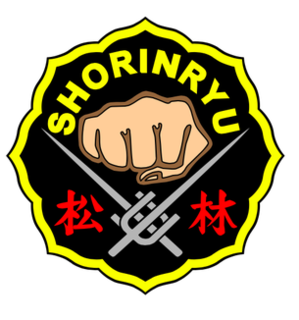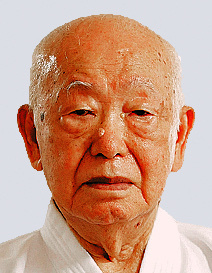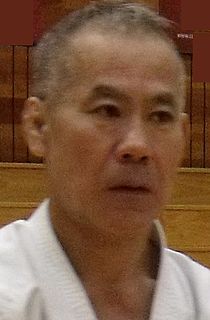Isshin-Ryū is a style of Okinawan karate founded by Tatsuo Shimabuku in 1956. Isshin-Ryū karate is largely a synthesis of Shorin-ryū karate, Gojū-ryū karate, and kobudō. The name means, literally, "one heart method". In 1989 there were 336 branches of Isshin-ryū throughout the world, most of which were concentrated in the United States.

Matsubayashi-Ryū (松林流), is a style of Okinawan karate founded in 1947 by Shōshin Nagamine (1907–1997). Its curriculum includes 18 kata, seven two-man yakusoku kumite routines, and kobudō (weapons) practice.
Okinawan Kobudō (沖縄古武道), literally "old martial way of Okinawa", is the weapon systems of Okinawan martial arts.

Chitō-ryū (千唐流) is a style of karate founded by Dr. Tsuyoshi Chitose, (1898-1984). The name of the style translates as: chi (千) - 1,000; tō (唐) - China; ryū (流) - style, school, "1,000 year old Chinese style." The character tō (唐) refers to the Tang Dynasty of China. The style was officially founded in 1946.
Shinken Taira was a Japanese martial artist, born as Shinken Maezato in 1897 on Kume island in the Ryūkyū archipelago.
Ryūkyū Kempo (琉球拳法) sometimes spelled Ryūkyū Kenpō is a generic term often used to describe all forms of karate from the Ryukyu Islands, and more specifically to refer to the particular styles associated with Taika Seiyu Oyata and George Dillman.

Kanki Izumigawa was a karate master who learned Goju-Ryu from Seiko Higa on Okinawa and Saipan. Higa had studied under Kanryo Higashionna and trained with Chojun Miyagi. In his youth Izumigawa also studied karate under Juhatsu Kyoda, who was himself a senior student of Kanryo Higashionna. Izumigawa was born in Okinawa to a samurai family and was the founder of the Senbukan Dojo, which had its headquarters in Kawasaki City and branches in Tokyo, Osaka, Ota, Yokoyama, Nagoya and even Hawaii. The Senbukan dojo was established in 1939 and was the first dojo of Okinawan Goju-Ryu on mainland Japan. Today, It's currently the oldest Goju-Ryu dojo in the world.

Sekō (Seiko) Higa was a Gojū Ryū karate teacher who was born in Naha.

Yamanni-ryū (山根流) is a form of Okinawan kobudō whose main weapon is the bo, a non-tapered, cylindrical staff. The smaller buki, such as sai, tunfa, nunchaku, and kama (weapon) are studied as secondary weapons.

Shūgorō Nakazato was an Okinawan martial artist. Described as a "one punch artist" by some of his American students, Nakazato developed his karate sparring into "a fine fighting art". He gave many demonstrations in Japan as well as abroad and had "many well-known students in the USA", Nakazato was designated as an "intangible cultural asset holder" by Okinawa Prefecture in 2000. He was awarded the Order of the Rising Sun, 5th Class with Gold and Silver Rays on November 4, 2007.
Matayoshi Kobudo is a general term referring to the style of Okinawan Kobudo that was developed by Matayoshi Shinpo (又吉眞豊) and Matayoshi Shinko (又吉眞光) during the twentieth century. Martial arts have been practiced by the Matayoshi family for over nine generations and draw influence from Japanese, Chinese and indigenous Okinawan martial arts styles.
Toshihiro Oshiro is a martial arts master and instructor from Haneji, Okinawa, Ryukyu, Japan.

Morio Higaonna is a prominent Okinawan karate practitioner who is the founder and former Chief Instructor of the International Okinawan Goju-ryu Karate-do Federation (IOGKF). He is a holder of the highest rank in Goju-ryu karate, 10th dan. Higaonna has written several books on Goju-ryu karate, including Traditional Karate-do: Okinawa Goju Ryu (1985) and The history of Karate: Okinawan Goju Ryu (2001). Martial arts scholar Donn Draeger (1922–1982) reportedly once described him as "the most dangerous man in Japan in a real fight."
Meitatsu Yagi is the eldest son of Meitoku Yagi and followed after him as a teacher and practitioner of Karate.
Minoru Higa is the Kaicho or federation president and Grandmaster of the Kyudokan School of Shorin-ryū. His efforts, along with that of his family, have made Kyudokan popular outside Okinawa.

Okinawa Karate-Dō Shōrin-ryū Kishaba Juku, also called, familiarly, Kishaba Juku, is Chokei Kishaba's private academy of the Matsubayashi-ryu style of Okinawan Karate. The Kishaba Juku was officially founded on February 1, 1998, but had been in existence as an informal karate study group since the late 1970s.

Masaji Taira is a leading teacher of Okinawa Goju Ryu Karate Do, and head of the Okinawa Gojuryu Kenkyu Kai. His teacher was Eiichi Miyazato, a student of Chojun Miyagi and the founder of the Okinawan Jundokan dojo. Taira's karate is that of his teacher and the Jundokan, with the addition of his novel approach to the application of the kata.
Motokatsu Inoue (1918-1993) was a Japanese martial artist, noted as the Grandmaster of Yui Shin Kai and Ryukyu Kobujutsu The first man to be awarded 'Hanshi' by Taira Shinken.
The Zen Okinawa Kobudo Renmei (全沖縄古武道道連盟) is a martial arts organisation that began in Okinawa in 1972, and promotes the martial arts of two experts, father Matayoshi Shinko and son Matayoshi Shinpo.
Ufuchiku Kobudo (大筑古武術) sometimes referred to as Ufuchiku Kobujutsu or Ufuchiku-Den is a form of Okinawan kobudō whose main weapon is the Sai, other weapons such as Bo, Eiku, tunfa, nunchaku, Tekko, Techu, Tenbi Rochin, and kama (weapon) are studied as secondary weapons.








